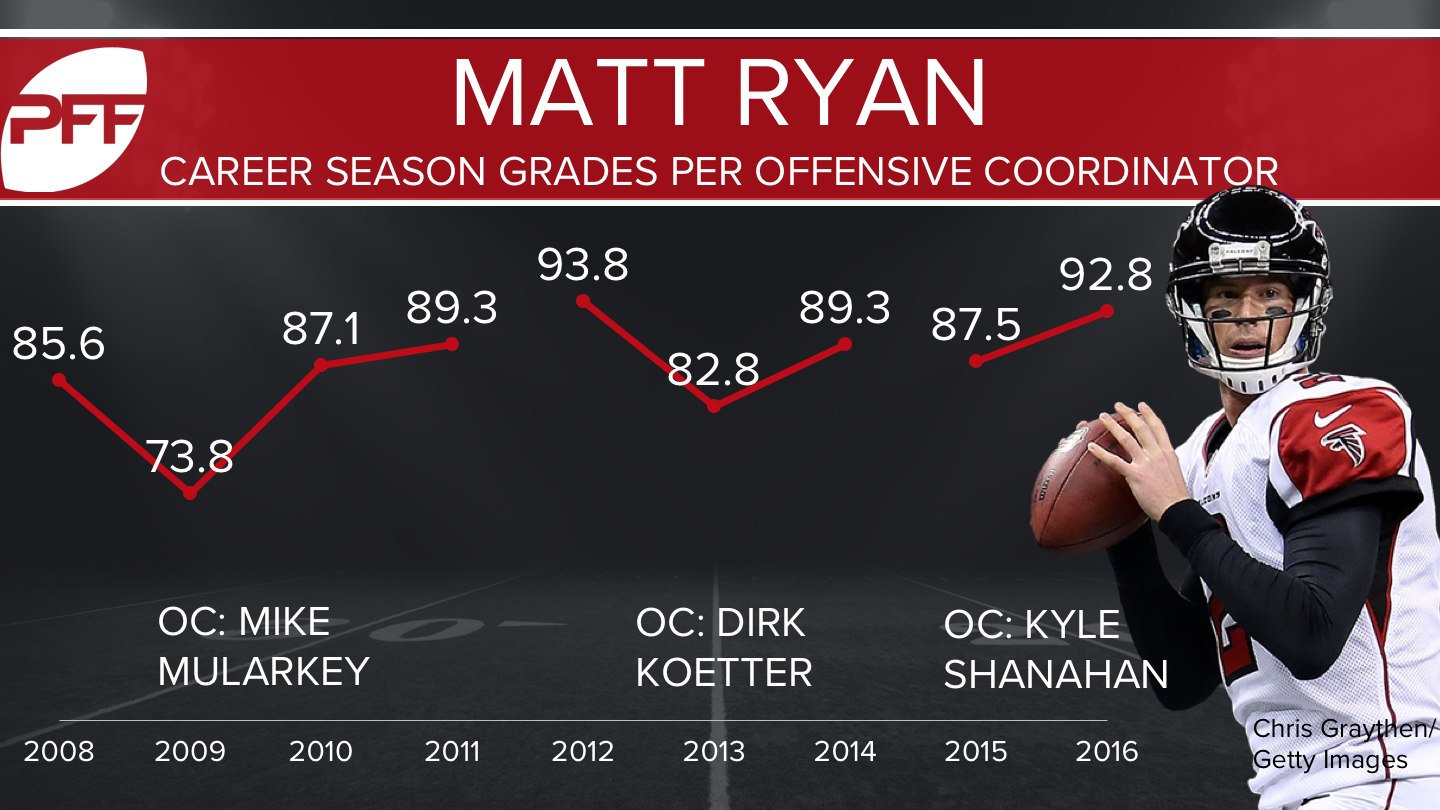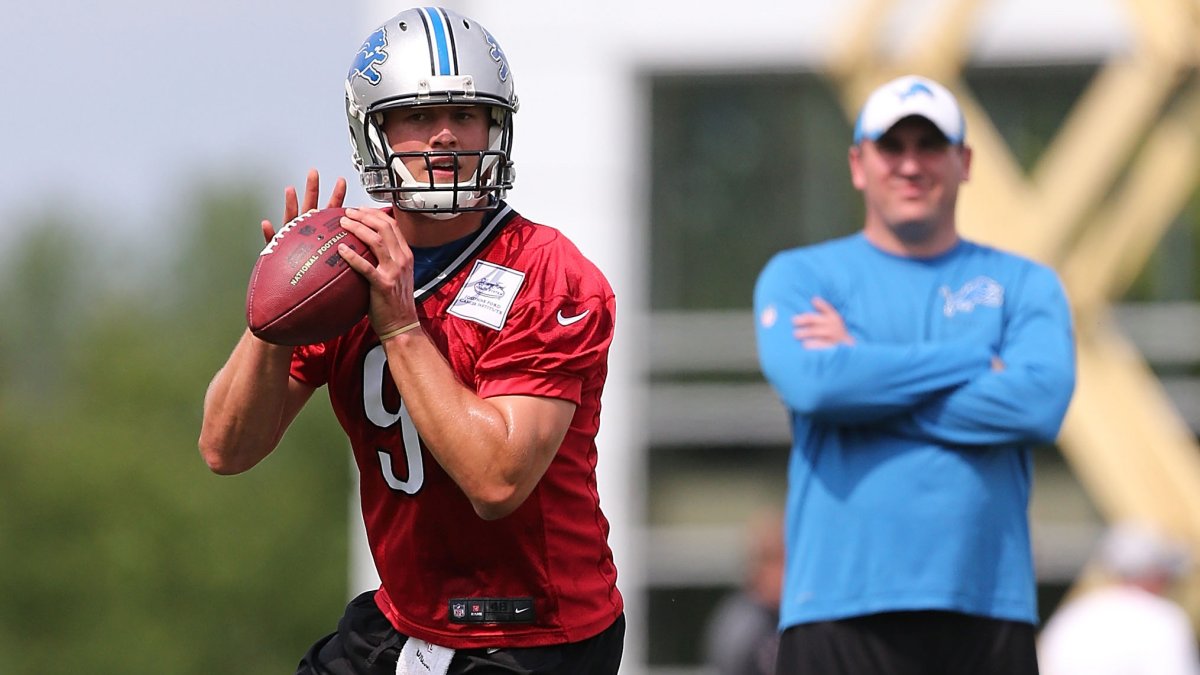In today’s NFL, player signings and teams shopping for new head coaches draw most of the interest for football fans every offseason. However, almost equally important, a change in an offensive coordinator can have a major impact in team success for a given season.
While the circumstances can vary, the turnover at the coordinator position can be intense, and there will be eight teams in 2017 with a different offensive coordinator other than the one they had entering the 2016 season.
Like a head coach or general manager, an offensive coordinator is often tied to the quarterback they either draft or inherit. A strong rapport between a coordinator and their signal-caller can make a huge difference for a team and the future of both the coordinator and player. If a coordinator helps a quarterback reach their potential (even if it's a one-year outlier), that could turn into an opportunity elsewhere for the OC. Due to this, many quarterbacks have had multiple offensive coordinators and how they respond to the changes can certainly vary:
Andy Dalton, Cincinnati Bengals
As a rookie in 2011, Cincinnati Bengals QB Andy Dalton had now-Washington Redskins head coach Jay Gruden as his offensive coordinator. Dalton posted a PFF grade of 75.1 in his first year, and saw a slight increase over the next two seasons posting a grade of 78.5 in 2012 and then in 2013 recording a grade of 79.3. After that 2013 season, Gruden got his chance in Washington and has been with the Redskins ever since. Taking Gruden's place in Cincinnati was Hue Jackson. Dalton regressed in 2014 in his first year with Jackson as he recorded a grade of 74.8. In 2015 however, Dalton made a major leap with what is to date a career best grade of 86.9.

Of course after that 2015 season, Jackson was named the head coach of the Cleveland Browns and will be entering his second year with the franchise. The Bengals named Ken Zampese their offensive coordinator for 2016 and in positive news for the franchise, Dalton had his best first season with a new coordinator to date with a grade of 80.3.
In Zampese’s system, Dalton saw a decline in his performance when under pressure as in 2015, his passer rating of 92.9 when under duress was third among quarterbacks, while in 2016 that figure dropped to 57.1 and ranked 26th. Despite the Bengals having some key losses to their offensive line this offseason, Dalton's track record of improving with each year under a new coordinator is an encouraging sign for the Bengals and their fans alike in 2017.
Matt Ryan, Atlanta Falcons
With Steve Sarkisian as the new Falcons offensive coordinator after Kyle Shanahan took the head coaching job with the 49ers, Matt Ryan is an intriguing quarterback to examine looking into the 2017 season. Shanahan not only was the coordinator under which Ryan had what is to date his second-best PFF season grade of 92.8 in 2016, but he's the only OC where Ryan's season grade increased in the second year of the system. Ryan led all quarterbacks in three of PFF's signature stats in 2016 . That includes a passer rating on deep passes of 136.1, an adjusted completion percentage when kept clean in the pocket of 84.1 percent and a passer rating of 116.5 when spending less than 2.5 seconds in the pocket.

After posting a grade of 85.6 as a rookie with Mike Mularkey calling the plays, Ryan saw a drastic dip in his second season grade which was 73.8. In his last two seasons with Mularkey, Ryan posted grades of 87.1 and 89.3, respectively. When Mularkey took the Jaguars head coaching job in 2012, Dirk Koetter filled the offensive coordinator position in Atlanta. Ryan saw immediate results under Koetter as he posted his career-best grade of 93.8 in his first season under his tutelage. The second season with Koetter saw a dip to 82.8 which could be tied into Julio Jones having a season ending injury in week five of the 2013 season as Ryan's grade bounced back to 89.3 in 2014. Coming off a career year to this point, it will be interesting to see the trajectory of Ryan's grades from here on out.
His overall grades have dropped off in his second season under both Mularkey and Koetter, Ryan has performed great in his first season under a new offensive coordinator. Will that keep up with Sarkisian in 2017?
Matthew Stafford, Detroit Lions
A great example of a coordinator and quarterback having a strong rapport is Matthew Stafford and Jim Bob Cooter.
From 2009 through 2013, Stafford had Scott Linehan as an offensive coordinator. Stafford had what was at the time his best PFF grade to date in his final season with Linehan, but a new head coach in many instances brings about a staff turnover. That was the case in 2014 as Joe Lombardi took over the coordinator role. Stafford's 2014 grade took a drop to 79.3 that season, which isn't a drastic drop compared to some others previously mentioned, however, Stafford really struggled in the first seven games of 2015 where Lombardi was the offensive coordinator. In that span, the Lions went 1-6, and Stafford only had one game with a grade that was at least “average” (70.0 or higher).

Jim Bob Cooter took over the play-calling for the Lions final nine games and Stafford responded. In six of the nine games, he had a game grade of average or better, including three that rated 83.9 or higher. Stafford's final season grade evened out to be 76.8 in 2015, but a full year of Cooter did make a difference in 2016. Stafford's season grade of 85.4 established what to this point is a personal best and had another personal best in terms of passer rating under pressure. His rating of 78.2 when under pressure ranked eighth among 34 qualifying quarterbacks. Heading into 2017 with even more familiarity of the Cooter-offense, there’s reason to believe we could see yet another increase in Stafford's performance.
The Bruce Arians Effect – Ben Roethlisberger & Andrew Luck
Before becoming the Arizona Cardinals head coach in 2013, Bruce Arians was known as one of the NFL's premier offensive coordinators. With that, he had the opportunity to work with two of the league's top quarterbacks in Ben Roethlisberger and Andrew Luck. Since Roethlisberger and Arians had an impressive five-year run which included five years of quarterback play in the “good” to “very good” tiers, it was interesting to see that Roethlisberger made a big jump in 2012, his first year with Todd Haley.
In 2011, Arians' last in Pittsburgh, Roethlisberger posted a PFF grade of 83.7 which ranked ninth among quarterbacks. However, in 2012 and working with Haley, Roethlisberger posted what was then a career-best grade of 91.6, fifth among all quarterbacks that season.

Although limited with his time with Luck, Arians’ only year with the Colts QB was during his rookie season and in 2012, Luck had a PFF grade of 77.4 which ranked 22nd among quarterbacks, but it didn't take long for him to make a leap. During the following year with Pep Hamilton as offensive coordinator, he had a nine-point jump to a grade of 86.4 that was good for ninth among quarterbacks. So what is it that could of attributed to Luck's leap in 2013?
Luck’s prowess on longer-developing plays made a huge impact on his grade as in his first, and only season, with Arians, he fielded a 66.8 passer rating when taking 2.6 seconds or more after the snap to throw, 26th out of 38 qualified quarterbacks. In 2013 however, he increased that to an 81.3 (19th) and even further in 2014 to a 91.6 (seventh).



 © 2025 PFF - all rights reserved.
© 2025 PFF - all rights reserved.